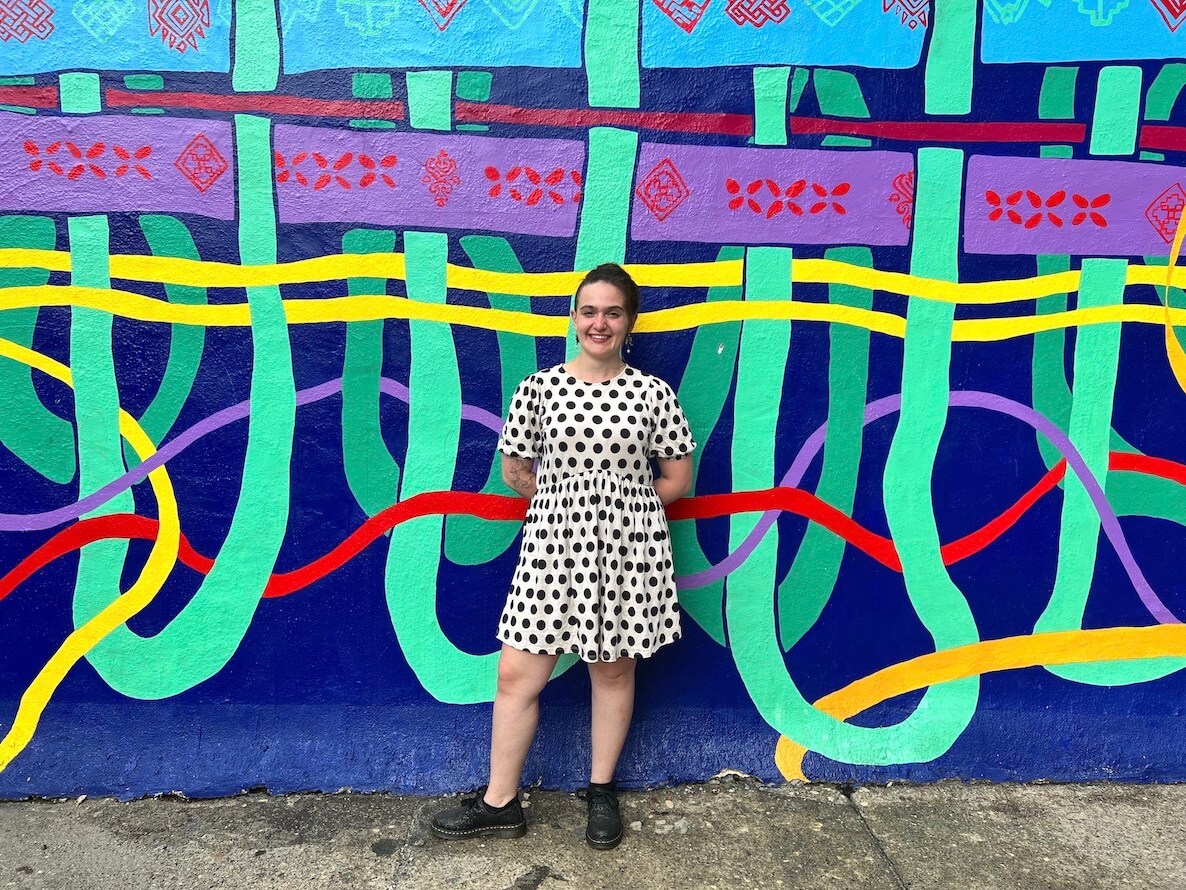For the last two-and-half years, Isa Segalovich has been going viral on TikTok. But not for stunning dance moves or Grimace Shake reactions. The South Philadelphia resident describes herself as an anti-authoritarian art historian. The videos she posts under the handle “interstellar_isabellar” highlight the unexpected intersections of art, politics, and history. While podcasts such as 99% Invisible and Radiolab demonstrated an audience for these types of stories, Segalovich has perfected them for the short-form video format. Where Radiolab can take upwards of an hour to allow a story to unfold, a typical TikTok might be only a minute or two — just enough time for one of Segalovich’s bite-sized history lessons.
How did she get here? Raised in Connecticut, Segalovich discovered Philadelphia while at Haverford College. There, she developed a love of visual studies — and of Philadelphia’s cultural community, especially the city’s oft-overlooked craftspeople, historians, and artists. Today, the TikTok creator boosts in-person creators’ profiles to an audience who otherwise might miss out. And she does so from a distinctly anti-racist, anti-fascist point of view.
@interstellar_isabellar Umbrellas for buildings! Pics are from my walk today. Look at that pretty sustainable multi family housing wow😉 #architecture #rowhome #brick #masonry #arthistory #BigComfy #sustainability #sustainable #housing #philly #philadelphia
For every video celebrating the ingenious ornamental design of Philly rowhomes or the beauty of traditional Greek clothing, there’s one on the influence of fascism on furniture design or the Barbie movie’s “bad feminism.” This makes Segalovich a modern historian in the mold of Howard Zinn, with the showmanship and enthusiasm of Bill Nye. Except in under a minute.
As part of a partnership with Forman Arts Initiative, the Citizen talked to Segalovich about her work and its impact. The interview has been edited for clarity.
RJ Rushmore: You and I both arrived in Philadelphia the same way: Haverford College.
Isa Segalovich: Yes. I was going to be a doctor, but I started failing my chemistry classes and got weeded out. So, I started taking classes with Christina Knight, who was a professor of visual studies. I had a major revelation about the way that aesthetics have a huge effect on the world. That got me interested in how we can use art to actually make a difference. I went on this expedition: How many different places could I volunteer and intern for in Philly that are working in art or social change? Through that, I fell deeply in love with the city.
I was an intern at the Association for Public Art. I volunteered at the Gross McCleaf Gallery. I worked at Arts Inc, a group that would go into Philly daycare facilities and lend a hand. That was probably one of the most fun times I’ve ever had, teaching a totally zany group of young kids how to use scissors and glue and that kind of thing. I interned at FringeArts for a semester. I was able to get funding from Haverford for that, which was the only way I could do it. I also did an internship at Philadelphia Assembled, which was a Philadelphia Museum of Art project creating this network of 500 arts organizations and other mutual aid groups.
How could the city better support and foster the arts community?
We need to have better structures for our crafters, a better scaffolding for our craft artists to grab onto. In a very basic sense, we obviously need more arts funding. We need to have a program where artists can apply and easily get the support that they need without having to beg from various private institutions just to be able to develop their craft.
When people talk about arts funding in Philly, the focus isn’t usually on crafters.
We’re a post-industrial town that has this huge legacy in fields like welding and brick work. We have beautiful decorative brick and wrought iron work. The metal work that’s on the top of our homes, the cornices, is unlike anywhere else. So many artists here are involved in those legacies, but they go largely unappreciated. I met recently with an iron worker who loves to produce decorative wrought iron work but just doesn’t have the support to do it.
This city’s craft history is unlike anywhere else in the country. On the plus side, you see incredible centers like The Clay Studio, The Fabric Workshop, the Museum for Art in Wood. We have the Philadelphia Museum of Art Craft Show, which is world famous. Still, Philly simply doesn’t get the love that it deserves, and the artists don’t get the support that they deserve.
People try to talk about how craft has now been lifted to the same level as fine art. But that’s just not true. There have been some cool exhibitions out there that have played with that idea, but craft is still relegated to the side.
What else don’t most people know about the Philly art scene?
A lot of extremely progressive movements have taken place here, which gives an edge to a lot of the art. This city is full of radical arts groups doing work that isn’t meant to be world famous, people just doing things for themselves. They’re not doing it to get a big headline. This is art that we should be paying attention to.” Which is a little bit topsy-turvy. Because I want to give a headline to it.
I see a lot of people banging their heads and asking, “How do I make revolutionary art and still make it as an artist?” I point to people that are making radical or revolutionary art in a variety of different ways, to suggest that this is a thing that you can do too. It’s not easy; it’s not usually going to come with a big paycheck, but it’s a thing that you can do. And that’s something that I do find a lot here in Philly.
Where are you finding that?
For example, our city government has not paid attention to Black history and architecture, or the homes that are here. The people at places like the Paul Robeson House, the Dox Thrash House, the Marian Anderson house, and the John Coltrane House are doing essential work. Preservation experts like Faye Anderson are trying to save these essential pieces of history. That legacy is crazy important, and it needs to be protected and uplifted. Not to mention the Sun Ra House in Germantown, and the living legacy that continues with their music!
You come at art from a political, progressive perspective.
I love finding the political in aesthetics. When most people talk about political art, their mindset is, “Oh, it has to be a political poster that’s saying something very explicit,” which ignores the political implications of most art. I’m trying to show how these things, politics and culture, are in the same world. Everything that we do in the art world has a political impact in some way.
One of the places it becomes the most clear is in architecture, particularly the way that buildings shape the way that we move. Our politics also shape the buildings that are built around us.
Political acts also have aesthetic consequences. I have been trying to deal with the way that fascism is in service of an aesthetic. People will look a certain way. Our streets will look a certain way. And this is why we would take it seriously that Le Corbusier was a fascist.
Are Instagram and TikTok the right format to discuss fascism and modernist architecture?
Yes and no. The major con is that I am extremely censored. I can’t say the words “fascism” or “Nazi” outright. I am a Jewish person talking about Nazi history, and it’s ridiculous that I have to censor myself.
Bans and suspensions are obvious, but there’s also being suppressed by the algorithm. There was about really almost a year where I had very, very few people viewing my content. There’s really no way to know exactly what happened. The only way I can explain it is that I was talking a little bit too much about Nazis. It’s really only been in the last six months or so that people have been able to see my face again.
Suppression is intended as a very blunt instrument for TikTok and Instagram to silence White supremacists, but those groups talk about these things by talking around them. For example, there are conspiracy theories rooted in anti-Semitism and White supremacy, and those go viral all the time. When that happens, it’s the anti-fascist educators who explicitly point out the roots of these conspiracy theories who get suppressed.
On the other hand, I get to be part of an amazing community of EduTok creators. Collectively, we’ve figured out how to make short engaging videos that illuminate hidden parts of history. There’s this idea that Gen Z especially is vapid, that they’re just totally jaded, and they don’t want to know about history. But it’s simply not true. Before I began, I did not think that people were going to be interested in the history of someone like Adolf Loos. And suddenly I have 200,000 people that are interested in learning about the relationship between White supremacy and Loos’ hatred of ornamental design. People on social media are hungry for more educational content, even critical historical content.
Speaking of content that could get you suppressed by the algorithm, I loved your series of videos about the history of the FKK [free body culture / nudist] movement in Germany.
I’m so glad. That is something I was obsessed with. I have so many things to say about these German nude beaches, especially a way of resisting the ways that capitalism makes us hate our bodies. FKK was discouraged during the Third Reich.
There’s a lot to be said about the fascist body politics of how you see yourself and how you’re allowed to present yourself, and capitalism is similar in that way. The most interesting thing about FKK right now is that the big real estate developers in Germany hate it. They don’t like people that they see as unattractive lounging on their property in the nude. And so it’s been on the decline as more big businesses move in.
Last question: should we have an FKK park in Philadelphia?
Yes! Oh, my gosh. There should absolutely be an FKK park in Philadelphia. It’s so good for body positivity. It’s so good for people to just be comfortable in the nude, in a playful, non-sexual way publicly with each other. This would be a great place for it.
Why not? Fairmont Park’s really big.
Fairmont Park’s so big.
Someone needs to tell the city to carve out a little corner.
It would be a real delight. I’m all for it.
RJ Rushmore is a writer, curator and public art advocate. He is the founder of the street art blog Vandalog and culture-jamming campaign Art in Ad Places. As a curator, he has collaborated with Poster House, Mural Arts Philadelphia, The L.I.S.A. Project NYC and Haverford College. Rushmore’s writing has appeared in Hyperallergic, Juxtapoz, Complex and numerous books. He holds a B.A. in Political Science from Haverford College, where his thesis investigated controversies in public art.
 This story is part of a partnership between The Philadelphia Citizen and Forman Arts Initiative to highlight creatives in every neighborhood in Philadelphia. It will run on both The Citizen and FAI’s websites.
This story is part of a partnership between The Philadelphia Citizen and Forman Arts Initiative to highlight creatives in every neighborhood in Philadelphia. It will run on both The Citizen and FAI’s websites.
![]()
MORE ARTS COVERAGE FROM THE PHILADELPHIA CITIZEN



